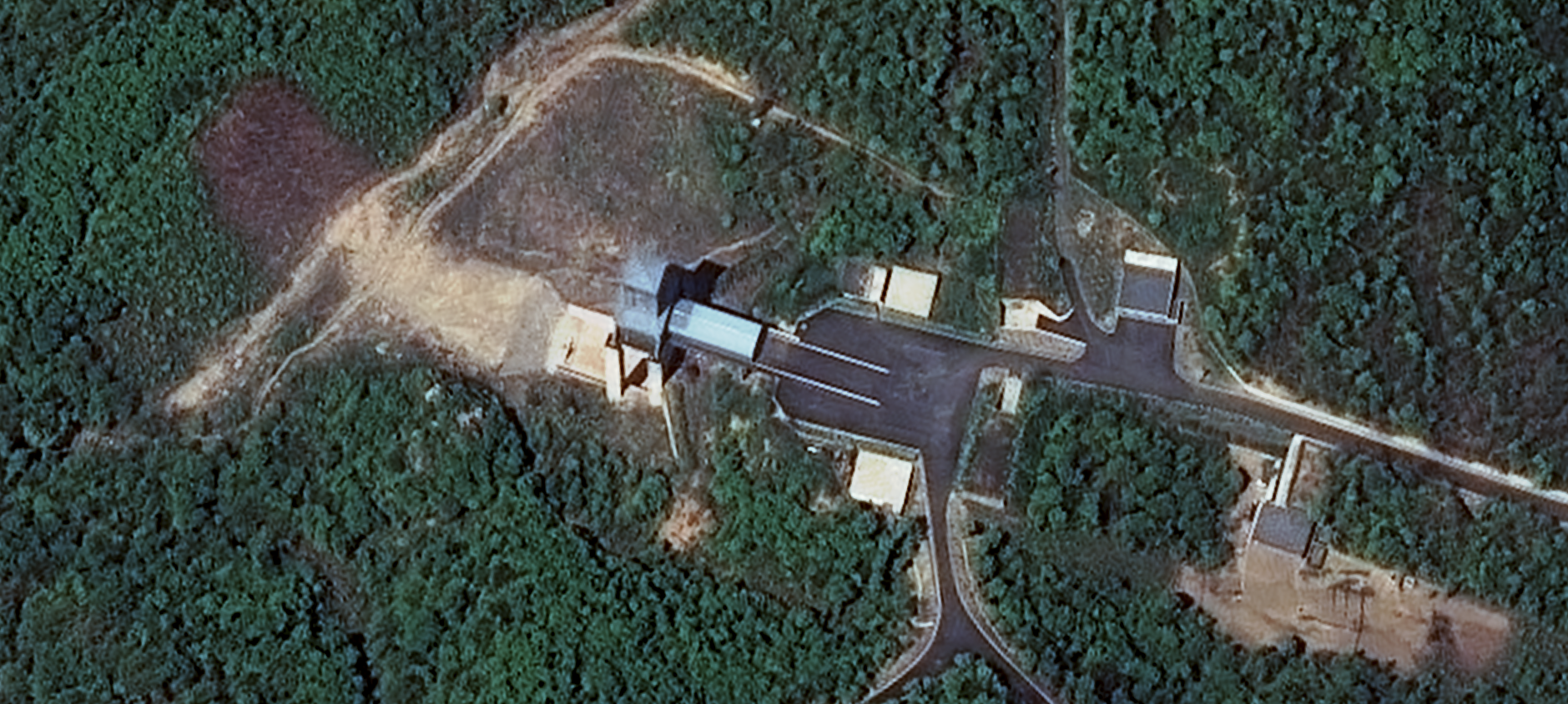
Vertical Engine Test and Ongoing Construction at the Sohae Satellite Launching Station
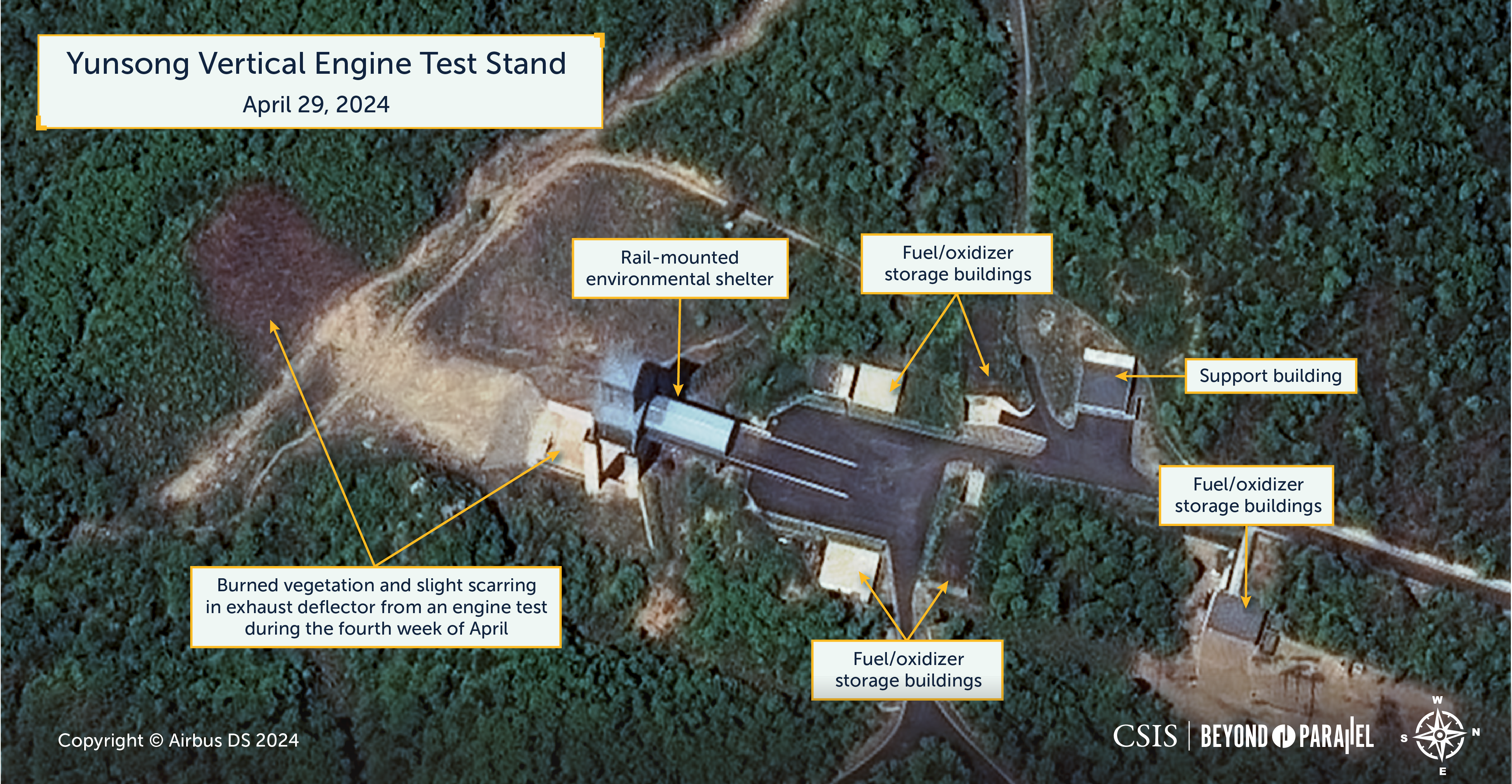
Key Findings
- The exceptional number of construction resources and finances allocated to the Sohae Satellite Launching Station underscore North Korea’s stated intention to field a diverse rocket and missile complex capable of supporting the development and launch of larger and more sophisticated space launch vehicles (SLV), satellites, and long-range ballistic missiles.
- Satellite imagery indicates that North Korea conducted an unannounced test of a liquid propellant rocket engine from the Yunsong vertical engine test facility during the fourth week of April 2024. Earlier in the month, several sources suggested that North Korea was preparing to conduct another satellite launch. While there were some indications that a launch attempt might occur within the month, it did not.
- While construction of the coastal launch pad is largely complete and work on refurbishing the original launch pad is largely suspended, work is now concentrated on constructing a large new processing/assembly building and an associated underground facility. Several smaller construction projects are also being pursued.
- It was from the Sohae Satellite Launching Station that North Korea conducted its first successful launch of a three-stage Chollima-1 SLV on November 21, 2023, that placed a Malligyong-1 “military reconnaissance satellite” into low Earth orbit.
- Any future launches of reconnaissance satellites or ballistic missiles from the Sohae Satellite Launching Station would inevitably use a combination of domestically developed and covertly acquired ballistic missile technology, an activity banned by the United Nations. If successful, a second reconnaissance satellite would provide an immensely improved capability to monitor locations within East Asia and the world.
Satellite imagery of the Sohae Satellite Launching Station shows that over the past year, North Korea has continued its large-scale development project for the facility. This project has demonstrated planning flexibility, achieved several significant goals, and is moving towards its stated goal of developing the facility into a diverse rocket and missile complex capable of supporting the development and launching of larger and more sophisticated SLVs, satellites, and missiles. The following are among some of the more significant aspects observed during the past year.
Coastal Launch Pad
Approximately 2.7 kilometers southeast of the original launch pad, construction of a new coastal launch pad for solid propellant SLVs (also useable for ballistic missiles) was completed in 2023. With the apparent suspension of the rebuilding of the original launch pad during the past year, the coastal launch pad has, by default, become North Korea’s sole satellite launch facility.1
North Korea conducted its first SLV launch attempt using a Chollima-1 SLV carrying a Malligyong-1 “military reconnaissance satellite” on May 30, 2023. This launch attempt was conducted from the coastal launch pad. This attempt failed due to a second-stage malfunction.2 A second launch attempt, also from the coastal launch pad, took place on August 23, 2023. This attempt failed, and the Chollima-1 SLV and Malligyong-1 satellite were destroyed.3 A third launch attempt was undertaken from the coastal launch pad on November 21, 2023, and was successful in placing a Malligyong-1 “military reconnaissance satellite” into low Earth orbit.4 Two days after the successful launch North Korea announced plans to launch three additional reconnaissance satellites.5
In early April 2024, several sources indicated that North Korea was preparing to conduct another satellite launch. While there were some indications that a launch attempt might occur within the month, it did not.
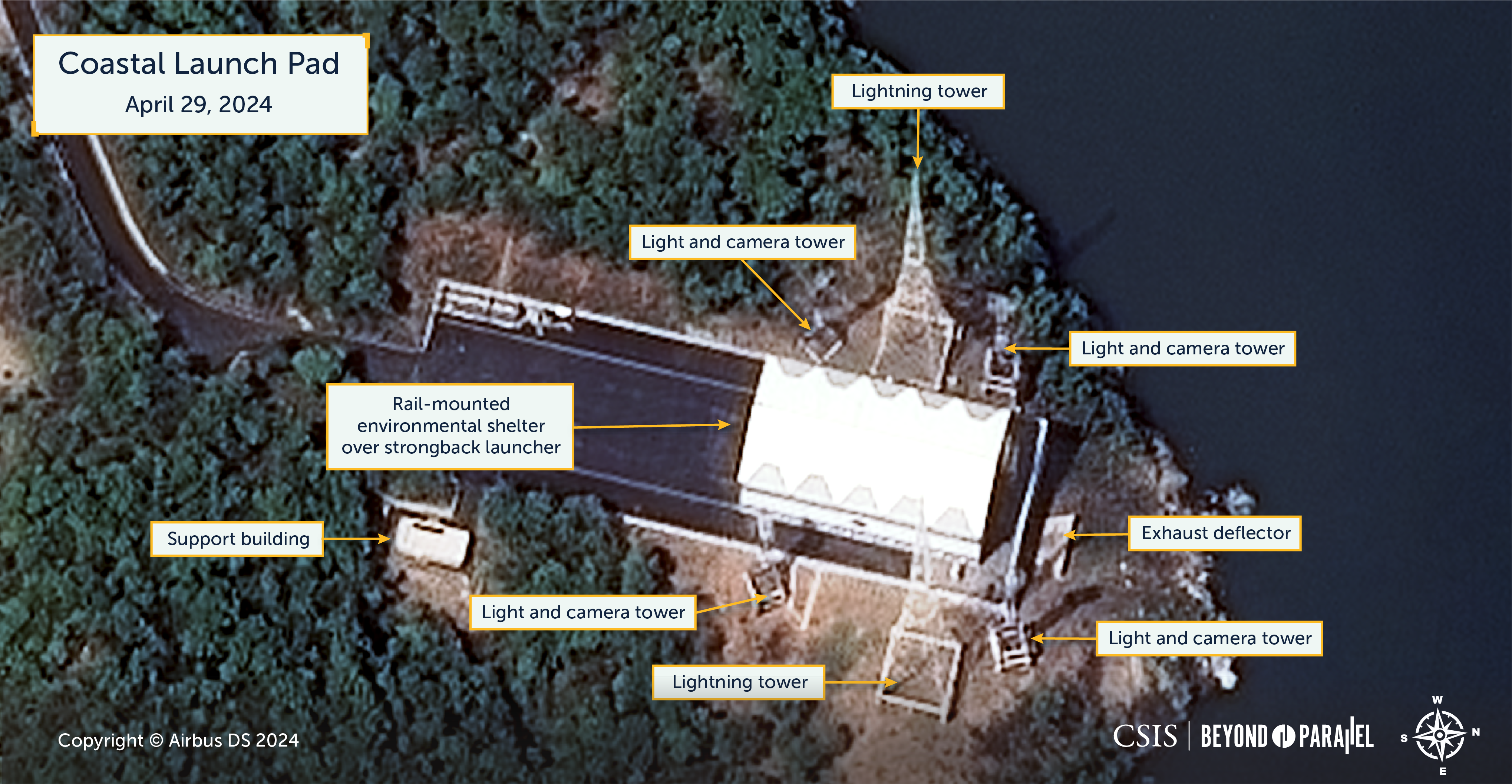
Yunsong Test Facilities
During the past year, several noteworthy developments have been observed at the Yunsong vertical engine test stand and the newly completed nearby test facilities.6
The dirt/sand piles previously stored on the servicing pad have been removed, and the vertical engine test stand was refurbished, including the installation of new roofing. Additionally, the rail-amounted environmental shelter underwent refurbishment, including the installation of new roofing, before being relocated to the test stand from its previous position at the center of the service pad.
Additionally, the servicing pad and ramp, as well as the access roads leading to both the test stand and the newly completed Yunsong horizontal engine test stand and Yunsong ballistic missile test silo, have been graveled as needed and subsequently paved.
On December 16, 2022, North Korean state media revealed the new Yunsong horizontal test stand when it reported on its first test event with Kim Jong-un in attendance. In March 2023, Kim observed North Korea’s first flight test (using a modified Hwasong-11) from the recently completed Yunsong ballistic missile test silo immediately east of the vertical engine test stand.7
The silo consists of a tunnel leading to an underground servicing chamber and a silo with an approximately 6-meter-by-6-meter cover. A year later, in March 2024, Kim observed another solid rocket engine test from the Yunsong horizontal engine test stand.8
Significantly, satellite imagery from April 29, 2024, and knowledgeable sources indicate that North Korea conducted an unannounced test of a large liquid propellent rocket engine from the Yunsong vertical engine test facility during the fourth week of April 2024. This test is a clear indication that North Korea is continuing to pursue the development of liquid propellent rocket engine technology for both its ballistic missile and SLV programs. It is unknown if Kim Jong-un was present for this test.

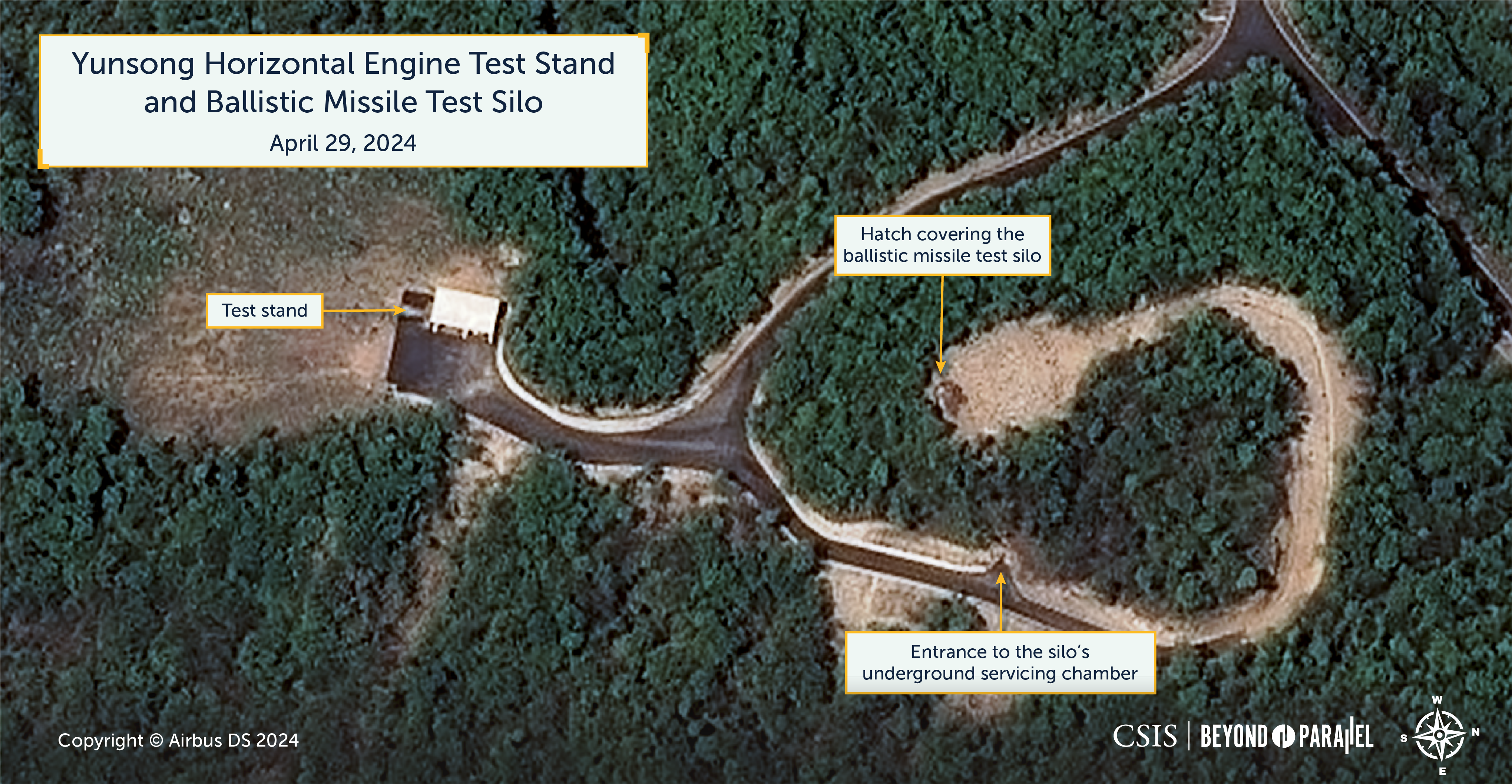
Northern Section of the Facility
Located 400 meters north of the entrance and checkpoint to the Sohae Satellite Launching Station is a rail-served warehouse that supports the ongoing construction throughout the station. During the past year, significant ongoing activity has been observed here as the numbers, sizes, and types of supplies, equipment, and vehicles continue to change with new deliveries.
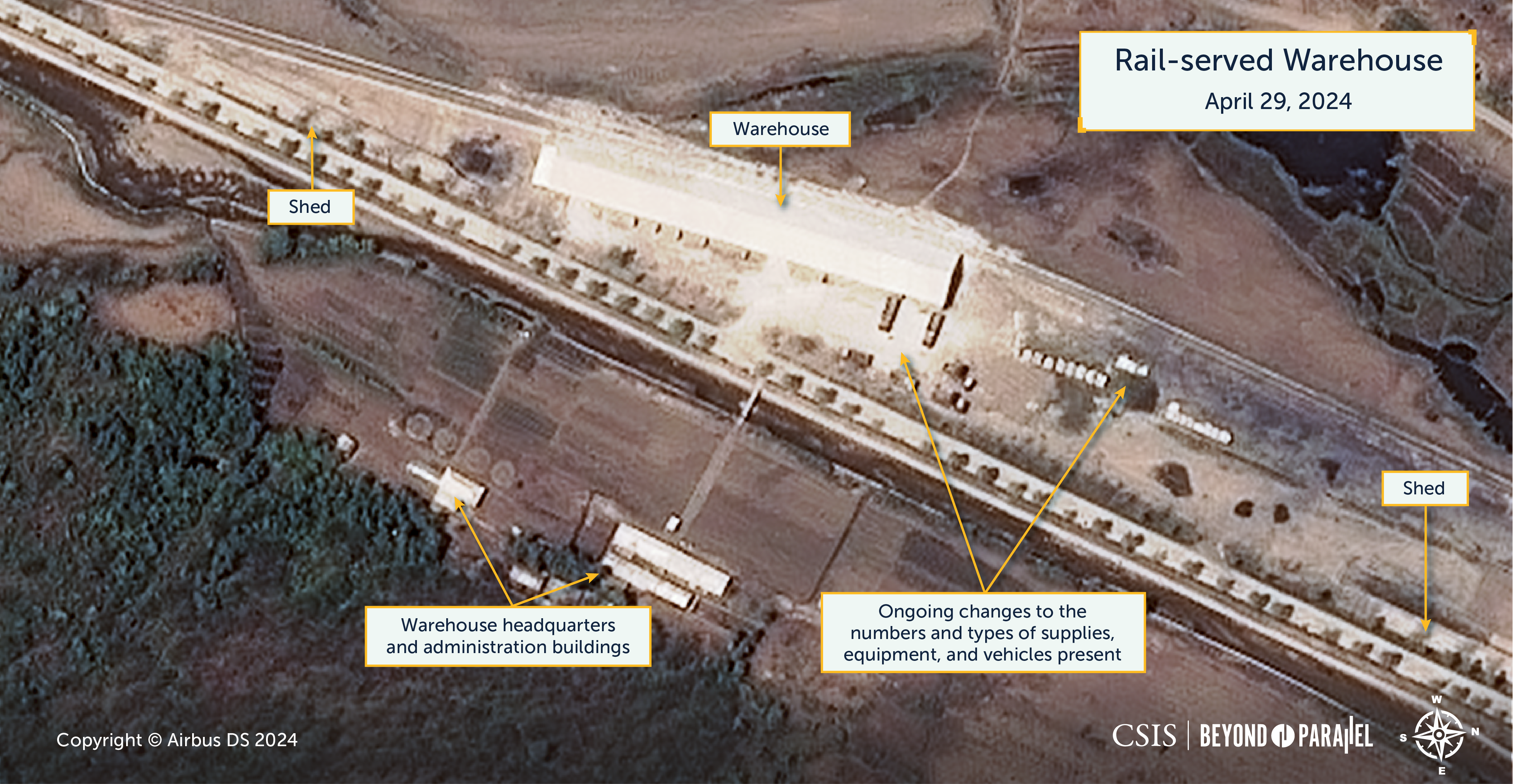
Although occasional vehicles or personnel on foot have been observed at or near the entrance and checkpoint during the same period, nothing of significance is noted except for the occasional vehicles or personnel.
Approximately 290 meters south of the entrance and checkpoint, the station’s administration and security headquarters consist of four buildings arranged around a central parking area. Although minor vehicle activity is typically observed here, a dramatically increased number of vehicles is frequently observed immediately before and after planned leadership visits, launch events, and engine tests. Such an increase was observed on April 8, 2024. However, no tests or visits are known to have occurred.
Immediately south of this compound is a temporary rail-served delivery point for sand/gravel for use in tunnel, foundation, and building construction. Ongoing activity has been observed here throughout the past year, including the arrival and departure of gondola rail cars carrying sand/gravel, the changing size and shape of sand/gravel piles, and the presence of various loading/unloading equipment and dump trucks.
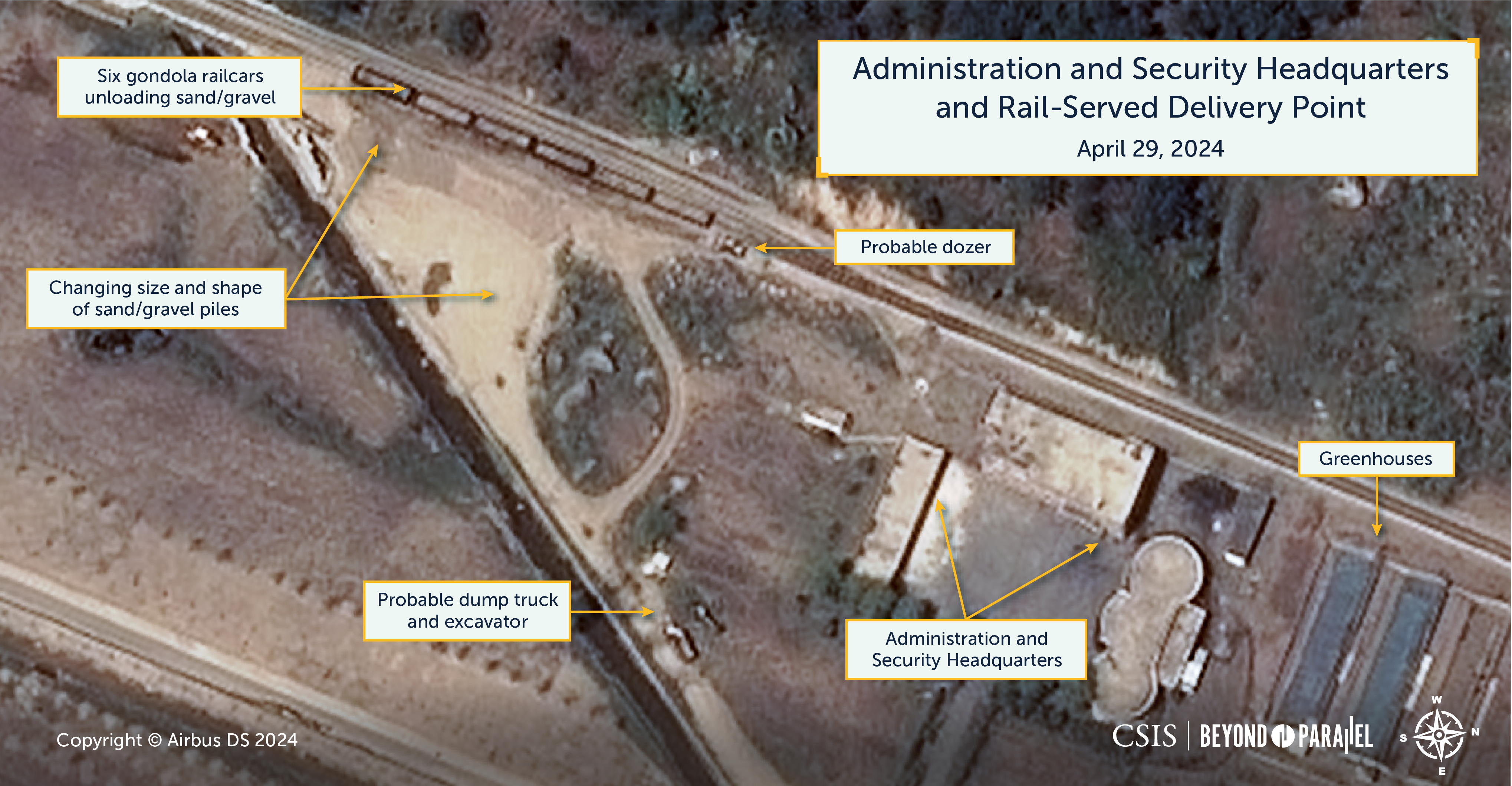
Further south at the horizontal processing building, which appears to now serve as a construction warehouse, the number and type of supplies stored around the building have continued to change over the past year. Minor changes are also noted in the storage yard to the west of the building. At the adjacent covered rail terminal, there are no indications of any significant changes, although it is very likely that it has remained in operation.
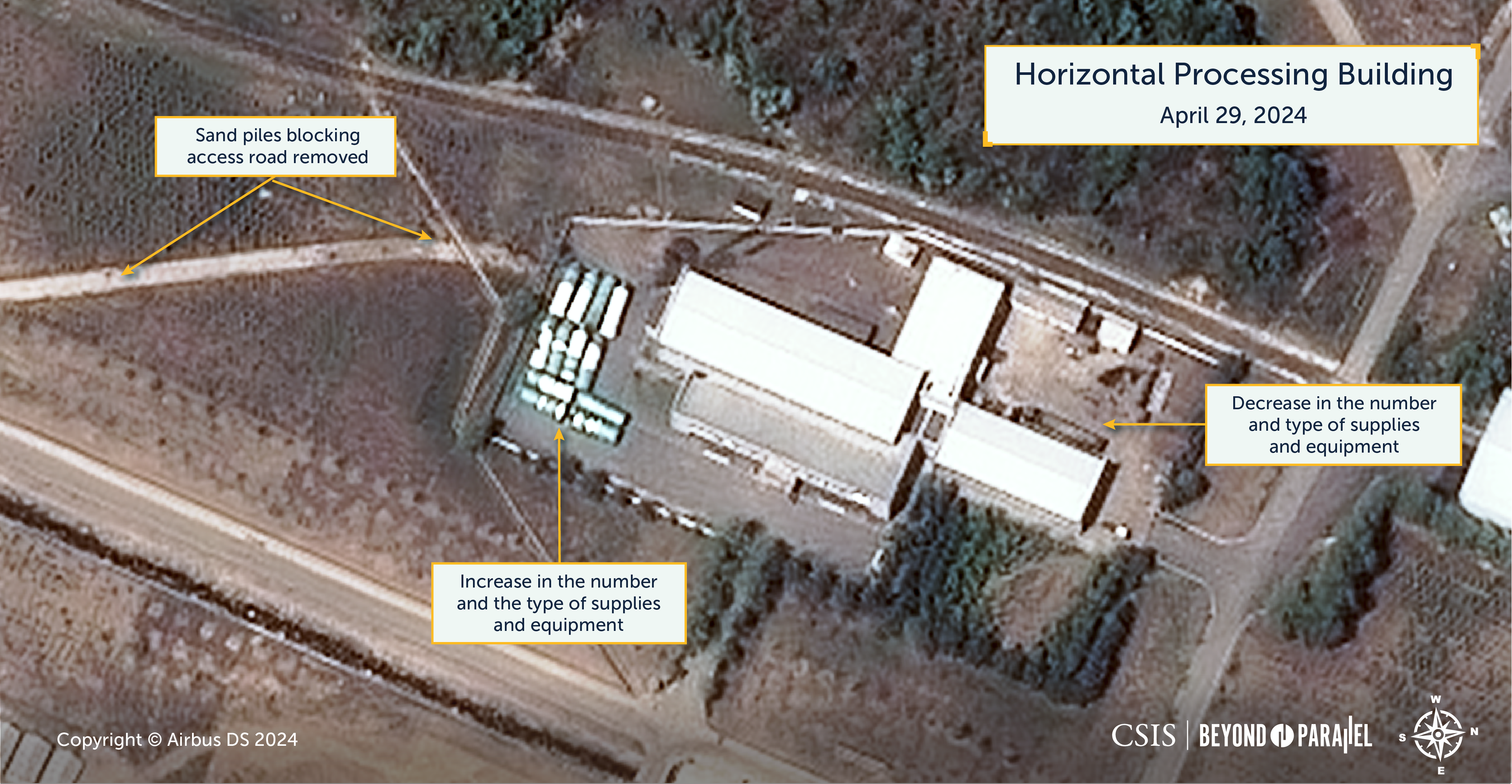
To the east of the original horizontal processing building, construction continues slowly on what appears to be a large new processing/assembly building measuring approximately 205 meters by 57 meters. This large building consists of two large central high-bay halls with single-story offices/shops/storage areas extending along the outer perimeter of both sides of the building. The high-bay halls measure 163 meters by 36 meters and 42 meters by 20 meters respectively, with the larger hall featuring a 10-meter-wide door, enabling it to accommodate several Chollima-1 class or larger follow-on SLV systems. Running east-west along the north side of the new processing/assembly building is a road under construction that leads to the large tunnel/underground facility that has been undergoing construction for the past two years.
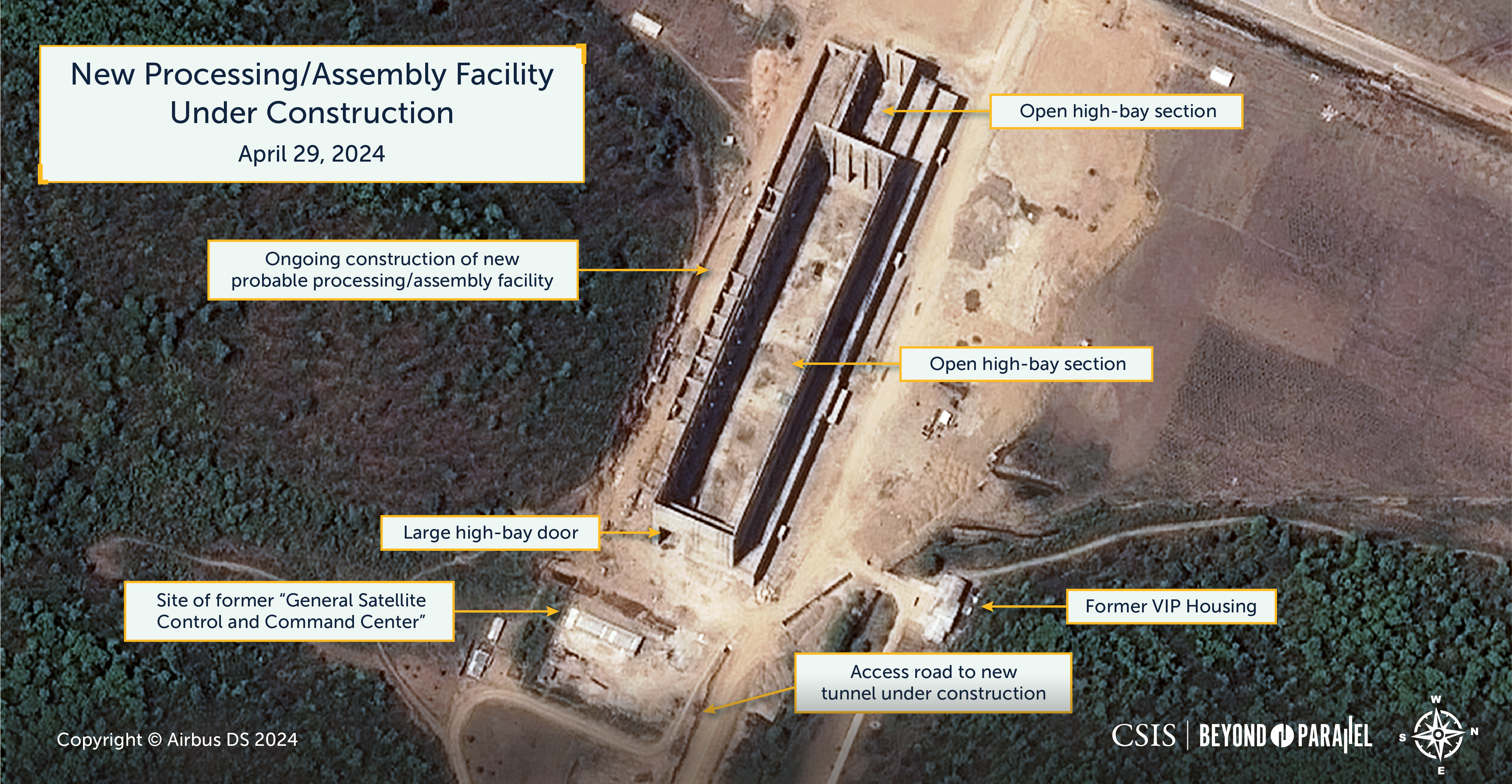
Underground Facility Construction
Up the valley east of the original horizontal processing building, North Korea has been building what is very likely a large underground facility rather than a basic tunnel for the past two years. This is indicated by the size of the portals on the eastern and western sides of the ridge, the architectural design of the portals, and evidence of the excavated waste materials.
During the past year, construction has expanded to include an access road leading from the Sohae Satellite Launching Station’s main access road. This road travels eastward past the new processing/assembly building and proceeds up to the west portal of the underground facility. Although the road is currently undergoing grading work, it is not yet ready for significant traffic. Once completed, it will likely aid significantly in the interior development of the underground facility.
The area around the portal has changed significantly during the past year. The graded area has nearly doubled in size, the first phase of portal construction has been completed and covered with earth, and the second phase has begun. This second phase includes the extension of the reinforced concrete portion of the portal further out.9 The forms for this new extension are clearly visible in the satellite image, along with curved steel support beams for the reinforced roof scattered on the ground near the construction site. Also visible on the ground are piles of grey gravel for mixing concrete. During this same period, approximately 20 support buildings at the construction site have undergone demolition, construction, or both.
At the east portal, significantly less activity has been observed during the past year, and construction, while not yet complete, appears to have dramatically slowed. Several support buildings have been built or razed, and the access road leading to the portal has been further graded but not graveled or paved. The presence of water drainage from the portal and the absence of substantial vehicle tracks suggests that construction efforts may have temporarily shifted elsewhere (e.g., the west portal). Immediately east of the portal area, the access road has been slightly rerouted and widened to accommodate a small new facility consisting of five buildings on the outskirts of the village of Changya-dong. The purpose of the facility remains unclear. Except for this small facility and the construction of a new VIP observation facility, no significant changes have been observed within Changya-dong.
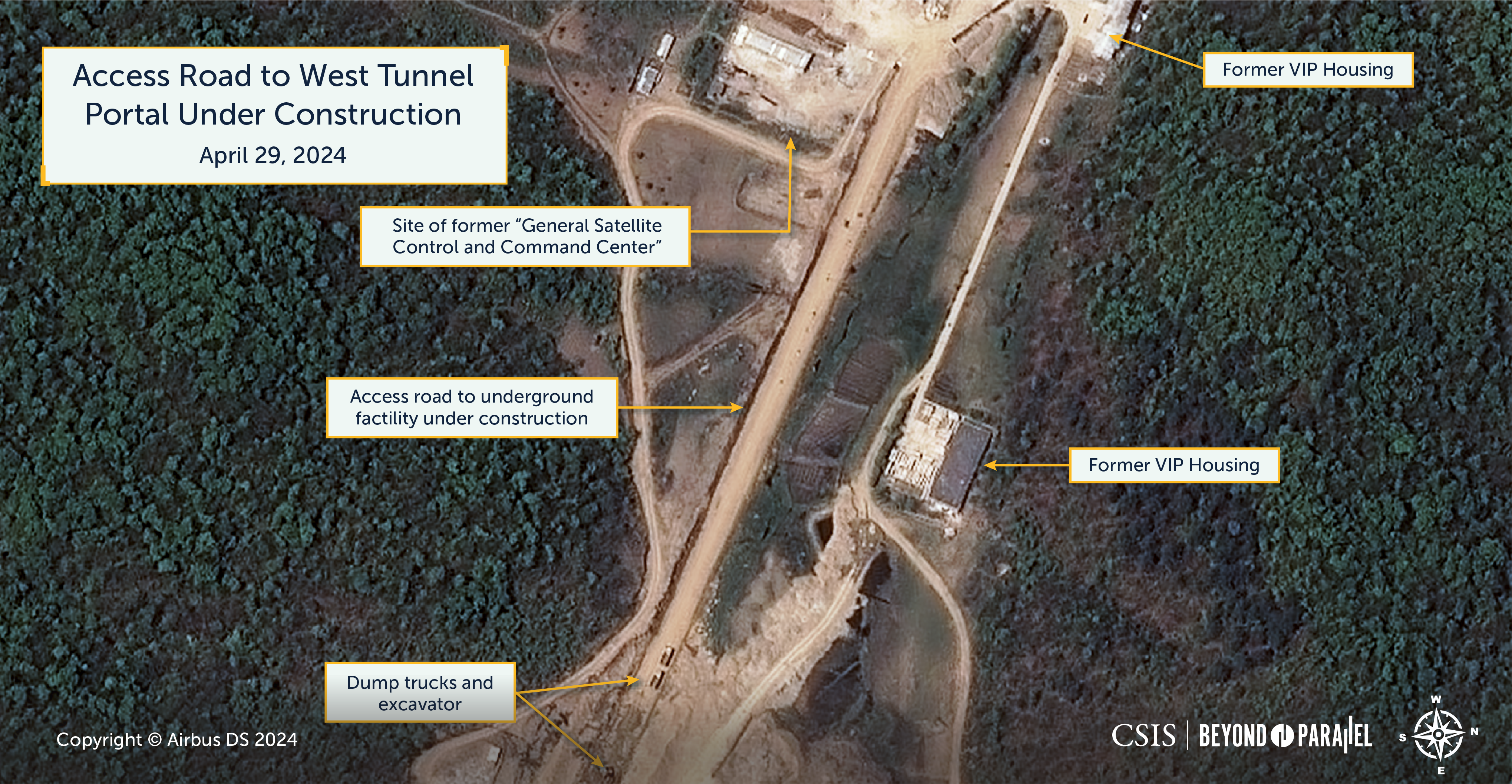
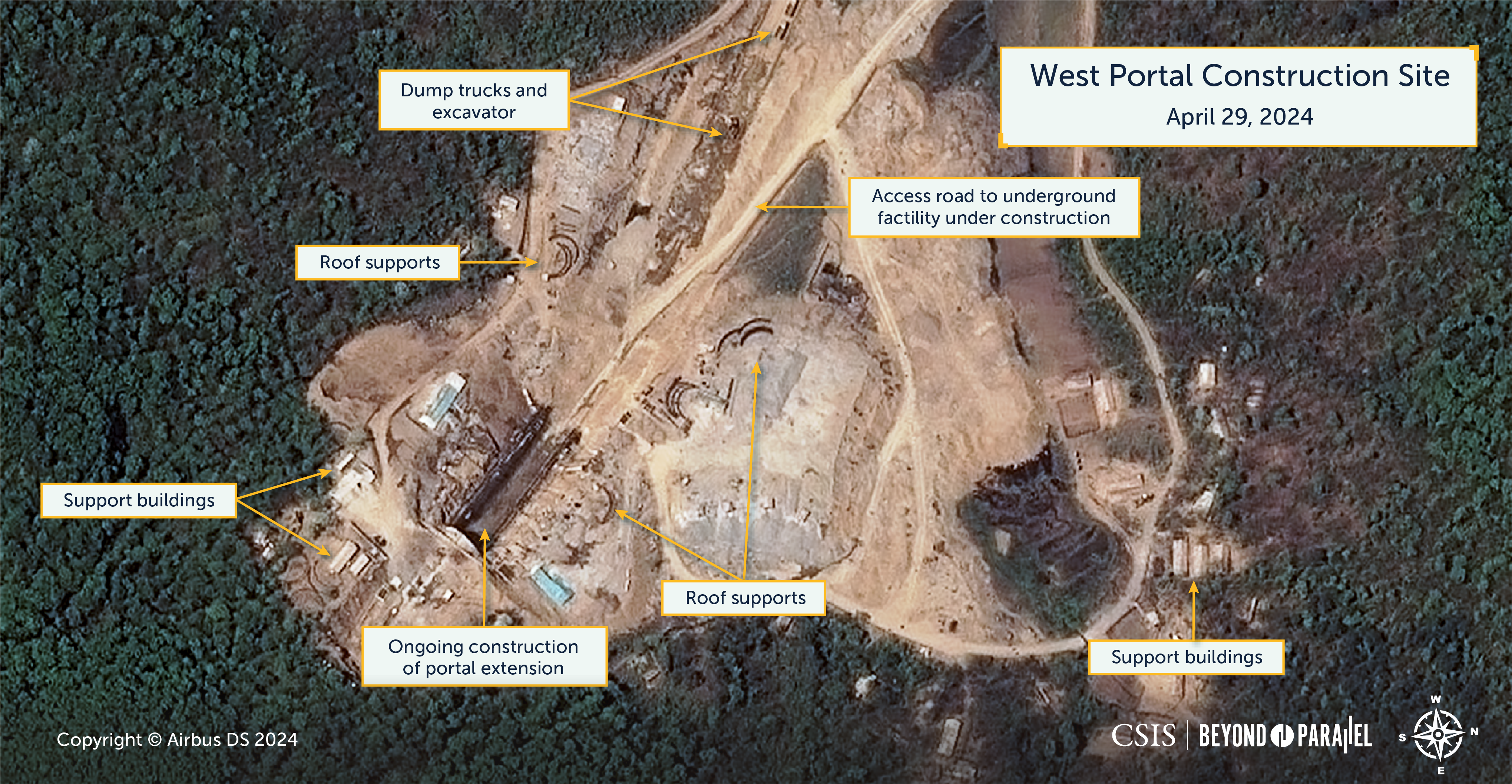
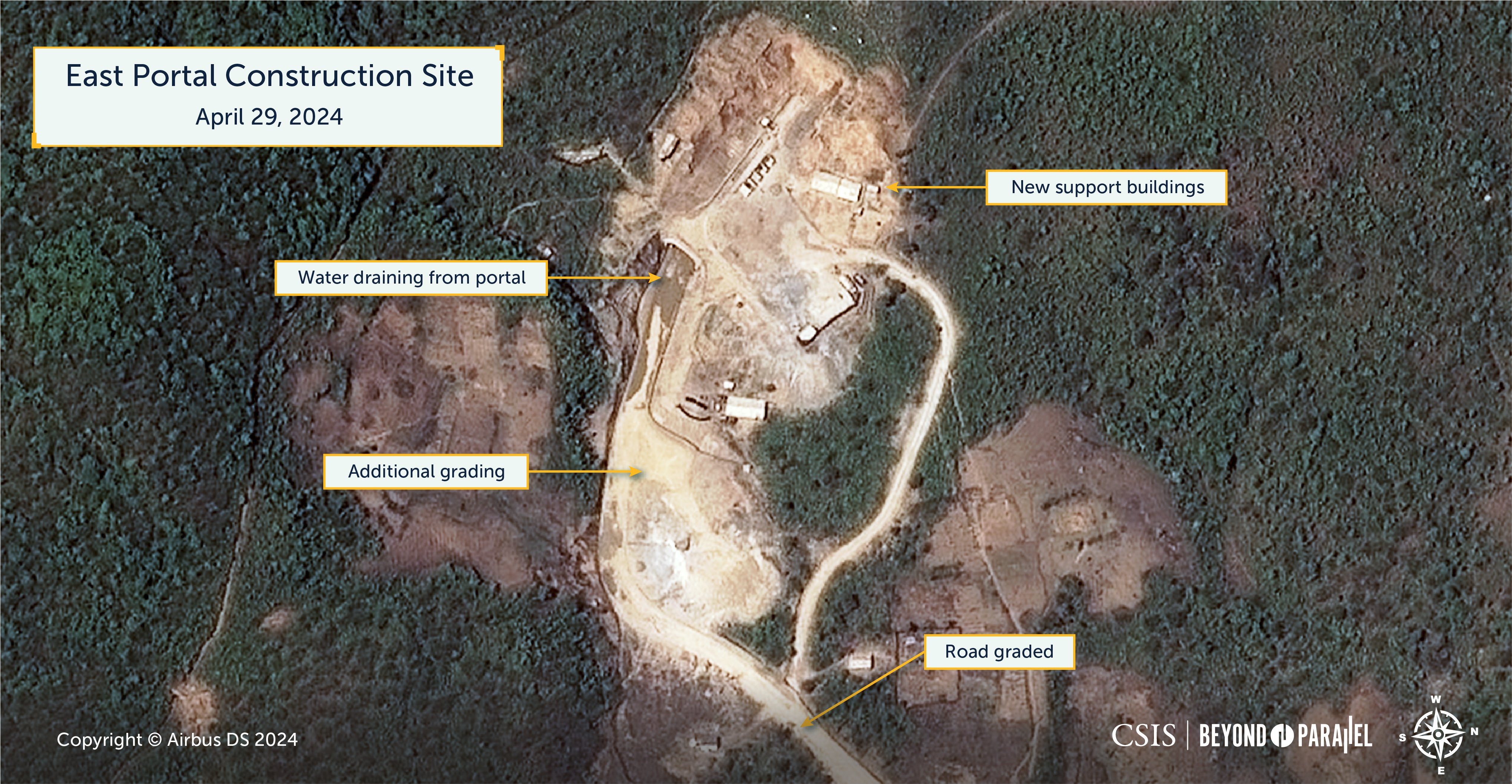
Original Launch Pad
Although there was some ongoing maintenance activity on the launch pad’s umbilical tower in mid-2023, this had been completed by later that year. Since then, the launch pad area has remained largely inactive, except for the movement of the rail-mounted transfer structure away from the opening over the underground rail transfer station and the completion of minor excavation around the entrance to that station. The rebuilding of the liquid fuel/oxidizer buildings and a new support building just southwest of the launch pad remains suspended. All necessary launch operations have been transferred to the coastal launch pad on the east shore of the Sohae Satellite Launching Station. While North Korea has invested heavily in the original launch pad, which was designed primarily for liquid propellent SLVs, it remains unclear when the rebuilding will complete.
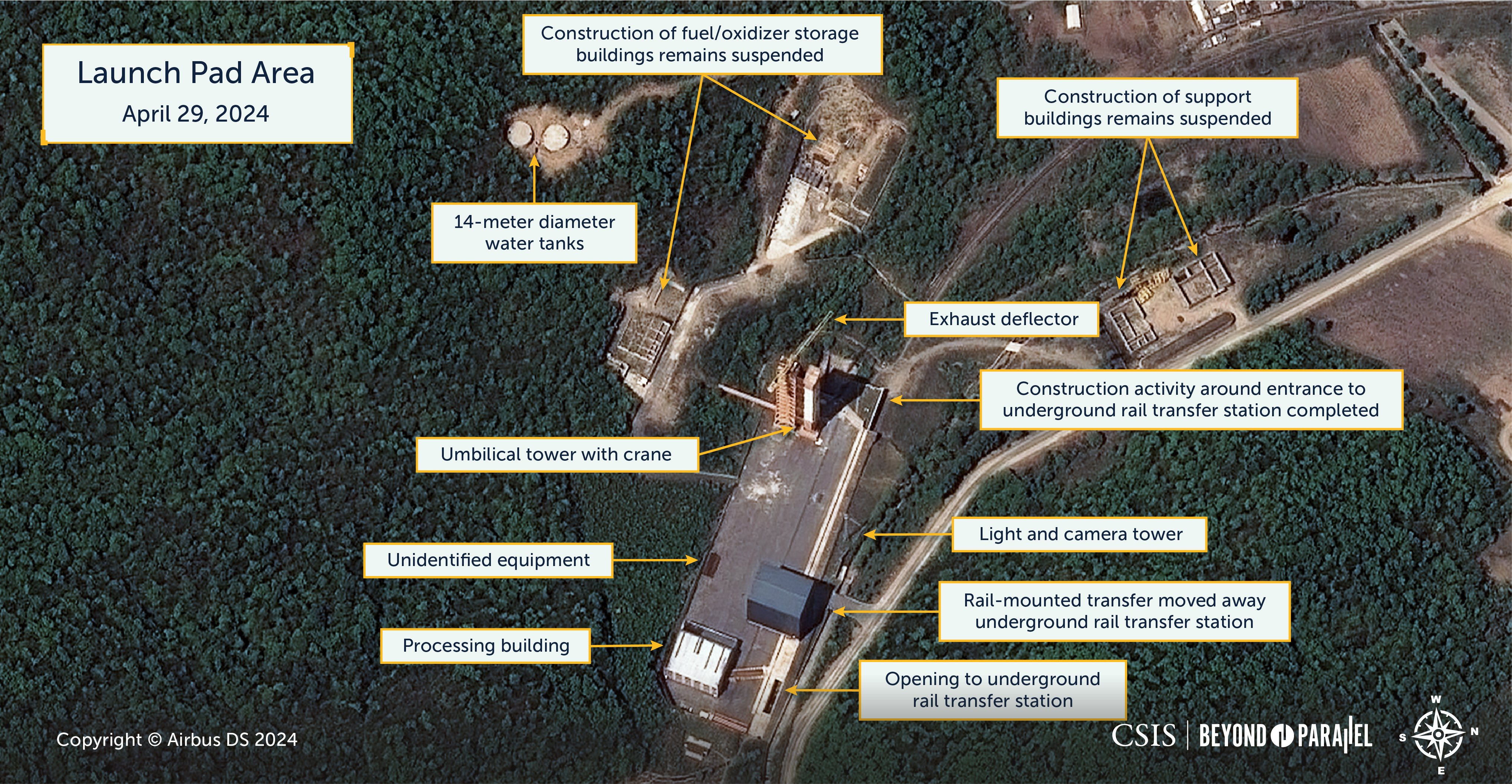
At the original VIP Observation Facility on the hill mass overlooking the original launch pad and the Yunsong test facilities, three vehicles and a trailer were observed on April 8, 2024. Historically, this number of vehicles and trailers has been observed immediately before and after engine tests and launch events. Yet, on April 10, the area was reduced to a single trailer, potentially for tracking purposes. The lingering presence of this trailer suggests that while a test or launch event may have been canceled, it remains in place to support future events.
Construction Support Compound
Located approximately 700 meters east of the original launch pad is a large construction support compound. The construction crews stationed here appear to be responsible for a majority of the heavy construction work undertaken throughout the southeast section of the Sohae Satellite Launching Station. Throughout the past year, there were ongoing changes to the numbers and types of supplies, equipment, and vehicles observed at this construction support compound.
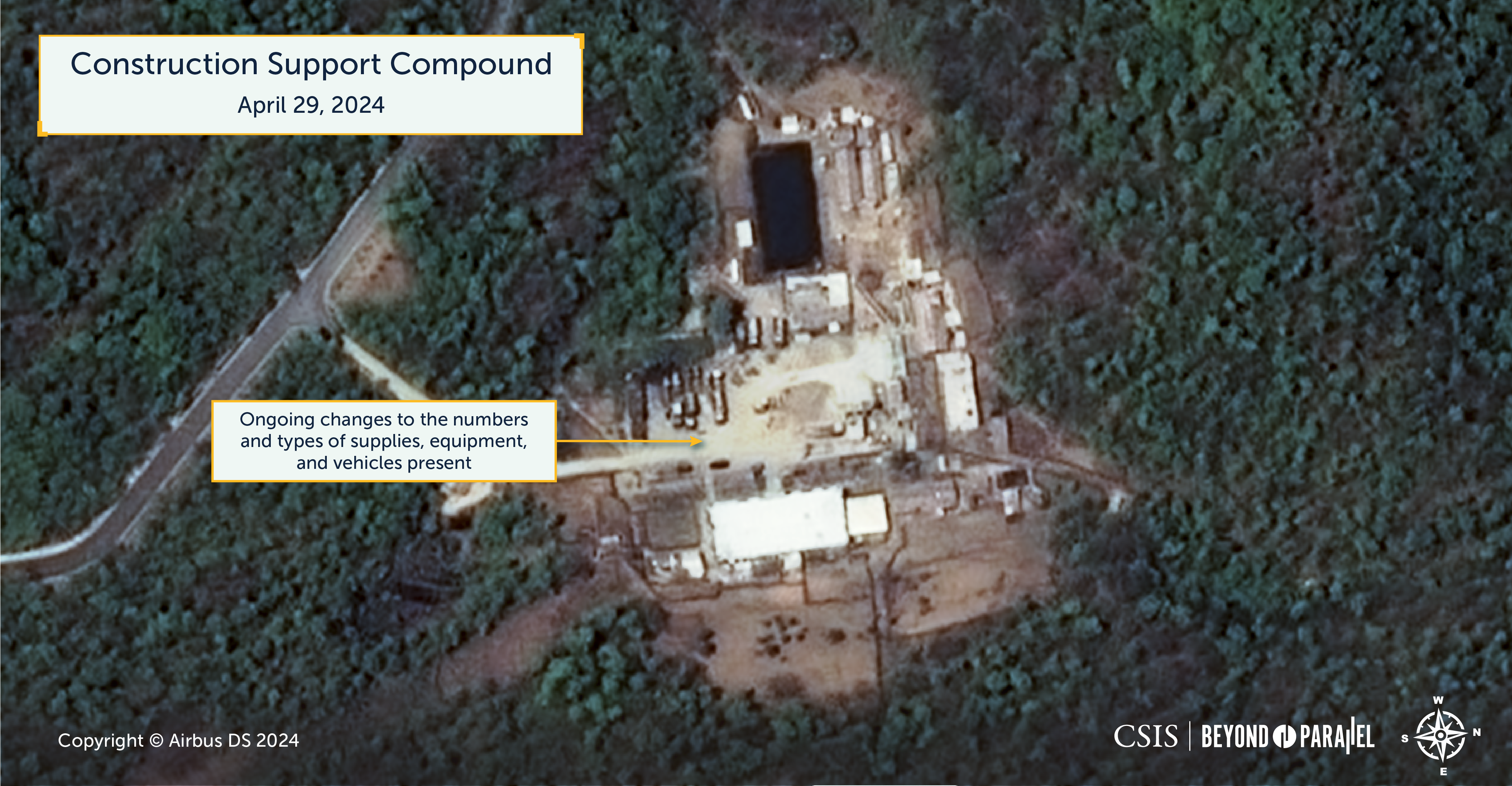
East Coast VIP Observation Facility
Approximately 1.3 kilometers northeast of the coastal launch pad, North Korea built a new VIP observation facility in 2023. Initially, this was a simple, large, flat, excavated, and landscaped parking area. It was from this site that the video and still images of the successful third launch attempt of the Chollima-1 SLV carrying the Malligyong-1 satellite were captured. In November 2023, North Korea began upgrading the facility by constructing a VIP observation building. As of April 29, 2024, the foundation and walls of this approximately 33-meter-by-17-meter facility were visible.
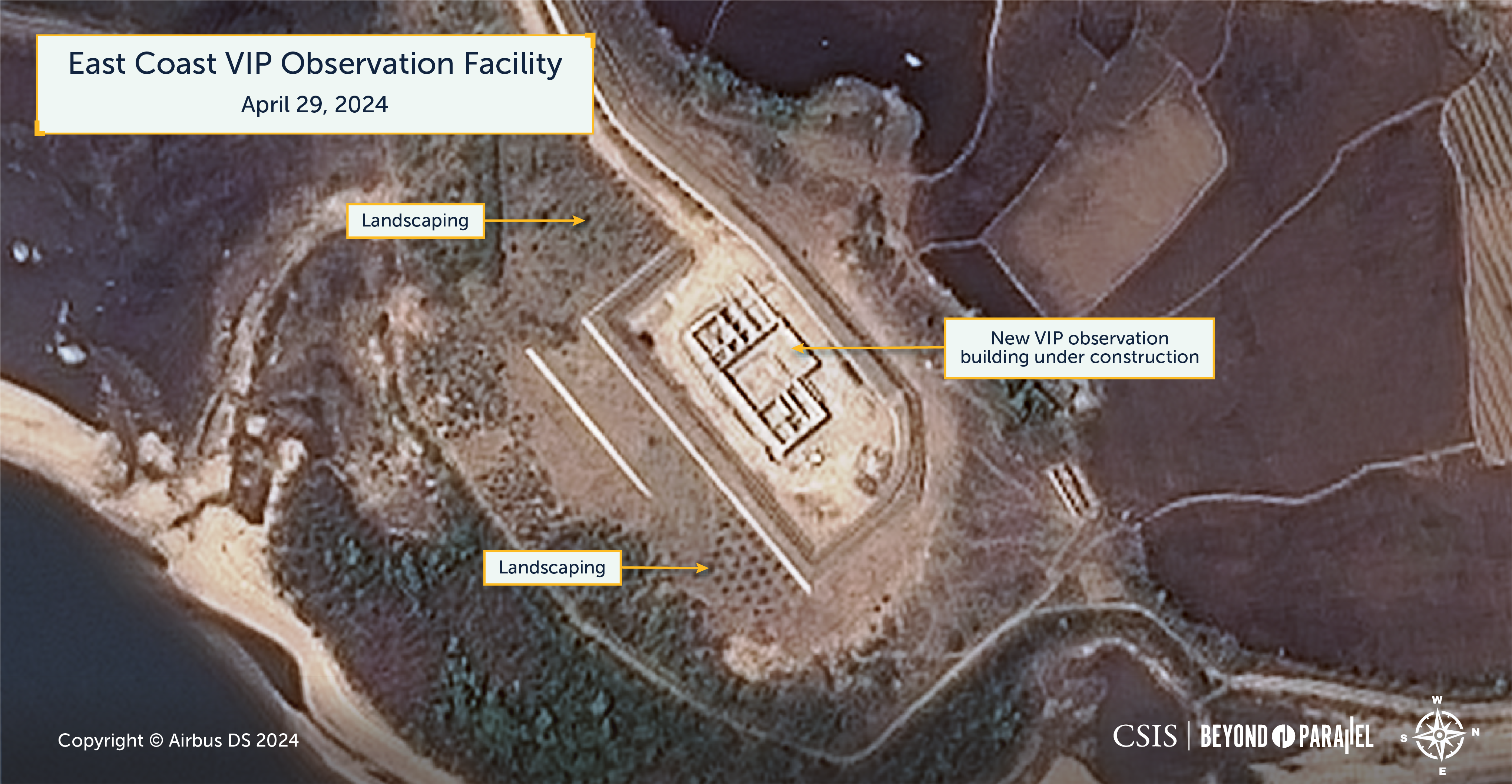
Construction Support, Barracks, and Housing Facilities in Yunsong Area
The high-priority nature and impressive level of the construction activity throughout the eastern section of Sohae are evident from both the expansion and ongoing activity at the construction support compound noted above and the construction of new support, barracks, and housing facilities in the Yunsong area.
Located east of the Yunsong horizontal engine test stand and the new east coast launch pad, North Korea has constructed a support facility adjacent to what is believed to be an old security barracks over the past several years. During the past year, the construction of this facility has been completed, and the old security barracks has been razed. As with the newly paved roads around the Yunsong test facilities, the road leading to this new support facility and the road connecting it to the new east coast roads have been paved. This east coast road is gradually being extended northward to the new VIP observation facility and southward to the new dock facilities in the village of Yunsong.
Further south, situated between the coastal launch pad and the Yunsong pier, another support facility, likely a barracks, has been undergoing construction since early 2023. This facility has now been largely completed, and the construction trailers have been removed. In 2024, a small facility was built 200 meters to the east of the support facility. It consists of six small buildings and may serve as a temporary worker housing facility.
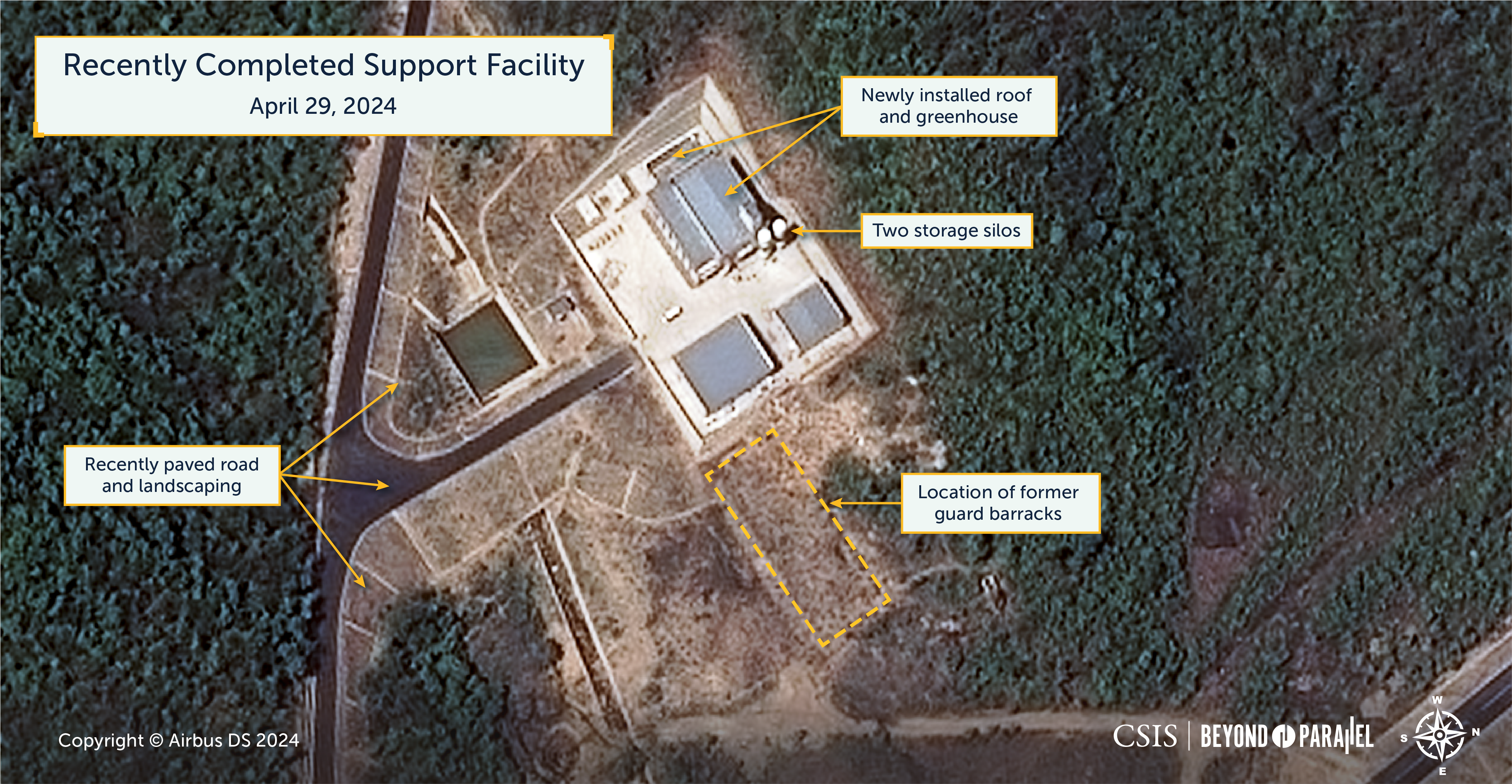
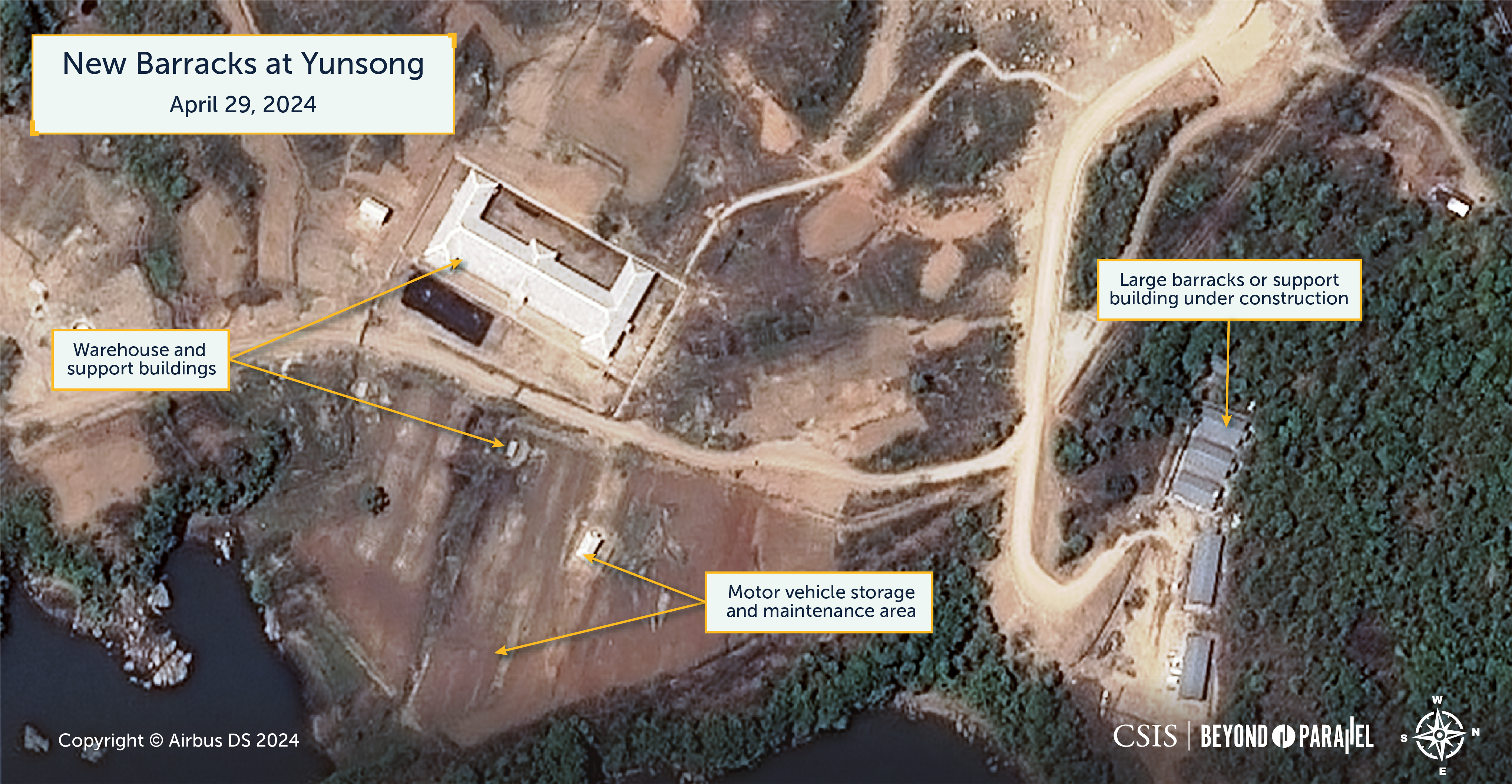
Yunsong Pier Construction
Located approximately 1.3 kilometers southeast of the coastal launch pad is the small fishing village of Yunsong. Since construction began for the development of the east side of Sohae, road construction to the village and efforts to dramatically expand the village’s docking facilities have been underway. Although the construction work has proceeded slowly during the past year, the pier, or seawall, extending out from the village has been slightly expanded, and additional concrete blocks or caissons have been delivered to build a seawall along the shore of the village.
The coastal waters in which the pier is being constructed are known to be inhospitable due to shallow waters and a high tidal range (extensive mud flats are exposed during low tide). Regardless, some sources suggest that the dock facilities at Yunsong could be developed into a viable alternative to the current use of rail transportation, allowing larger SLVs or ballistic missile components to be transported via water.
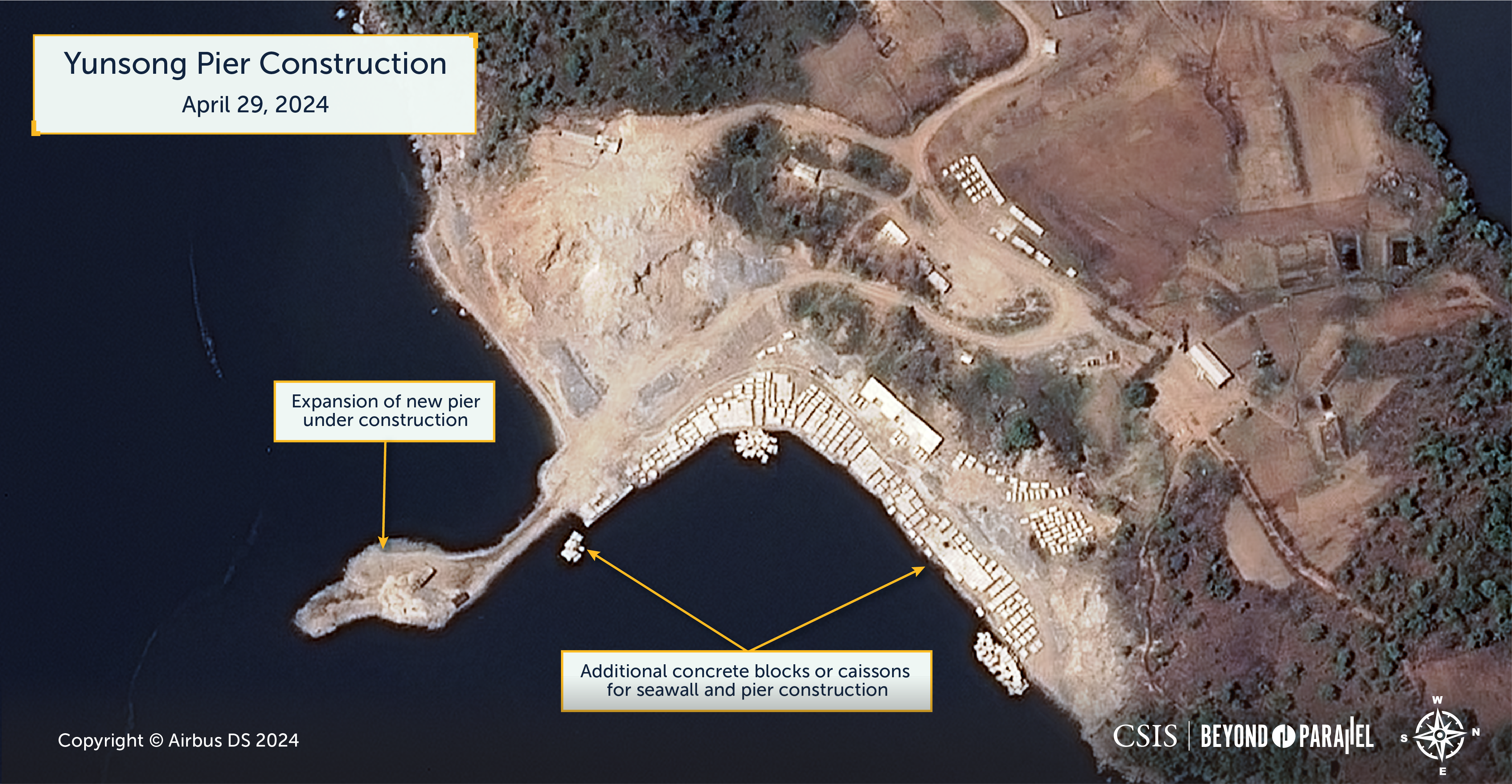
Western Section of the Facility
Minimal significant activity has been observed within the western section of the Sohae Satellite Launching Station. The existing infrastructure, including the National Aerospace Technology Administration (NATA) launch control and observation building,10 NATA support building, associated helicopter landing pad, livestock facility at Komun-dong, and warehouse facility, all appear to be actively maintained.
References
- If pressed, North Korea possesses the capability to launch an SLV from a temporary or presently unknown static launch facility or potentially even a transport-erector-launcher (TEL). ↩
- KCNA, “KCNA Report,” KCNA Watch, May 31, 2023, https://kcnawatch.org/newstream/1685496981-427573091/kcna-report/. ↩
- KCNA, “KCNA Report on Accident in Second Launch of Military Reconnaissance Satellite,” KCNA Watch, August 24, 2023, https://kcnawatch.org/newstream/1692828384-581600745/kcna-report-on-accident-in-second-launch-of-military-reconnaissance-satellite/. ↩
- KCNA, “DPRK NATA’s Report on Successful Launch of Reconnaissance Satellite,” KCNA Watch, November 22, 2023, https://kcnawatch.org/newstream/1700611622-680414227/dprk-natas-report-on-successful-launch-of-reconnaissance-satellite/. ↩
- “Report on the 9th Enlarged Plenum of 8th WPK Central Committee,” Rodong Sinmun, December 13, 2023. ↩
- The vertical engine test stand is used to test liquid propellant engines. ↩
- Hyonhee Shin and Minwoo Park. “North Korea’s use of missile silo could mean less warning of launches – analysts,” Reuters, March 20, 2023, https://www.reuters.com/world/asia-pacific/north-koreas-use-missile-silo-could-mean-less-warning-launches-analysts-2023-03-20/. ↩
- The horizontal engine test stand is used to test solid propellant engines. “Respected Comrade Kim Jong Un Guides Ground Jet Test of Solid-fuel Engine for New-type Intermediate-range Hypersonic Missile,” Rodong Sinmun, March 20, 2024. ↩
- This extension is likely due to a combination of slope and the composition of the hillside. ↩
- The National Aerospace Development Administration (NADA) changed its name in September 2023 to the National Aerospace Technology Administration (NATA). ↩
